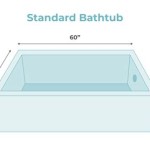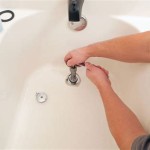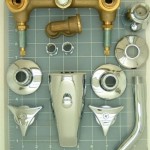Can Marine Paint Be Used On A Bathtub? A Comprehensive Exploration
The question of whether marine paint can be applied to a bathtub is a frequently debated topic among homeowners and DIY enthusiasts embarking on bathroom renovation projects. While the prospect of using a highly durable and water-resistant paint specifically designed for marine environments on a bathtub seems appealing, there are a multitude of factors to consider before making such a decision. This article will delve into the properties of marine paint, the typical construction and challenges associated with bathtubs, and the potential risks and benefits of using marine paint in this unconventional application.
Marine paint is engineered to withstand harsh environmental conditions, particularly constant exposure to saltwater and sunlight. This necessitates superior adhesion, flexibility to accommodate temperature fluctuations, and resistance to corrosion, blistering, and fading. Traditional marine paints often contained high levels of volatile organic compounds (VOCs), which contributed to durability but raised environmental and health concerns. Modern marine paints are increasingly formulated with lower VOC levels while still maintaining a high degree of performance. These paints are typically epoxy or polyurethane based, offering excellent protection against the elements.
Bathtubs, on the other hand, are typically constructed from materials like acrylic, fiberglass, cast iron, or porcelain-enameled steel. Each of these materials possesses unique characteristics that influence the type of coatings that can effectively adhere and perform over the long term. Acrylic and fiberglass bathtubs are relatively lightweight and flexible, making them susceptible to cracking if subjected to rigid or inflexible coatings. Cast iron bathtubs are incredibly durable and stable but can be prone to rust if the enamel coating is compromised. Porcelain-enameled steel bathtubs offer a combination of durability and affordability but can chip or scratch if not properly maintained.
The primary concern when considering the use of marine paint on a bathtub lies in the potential incompatibility between the paint's chemical composition and the bathtub's surface material. The paint's adhesion properties may not be optimized for the specific substrate, leading to peeling, chipping, or blistering over time. Furthermore, the expansion and contraction rates of the paint and the bathtub material may differ, resulting in stress cracks and eventual coating failure. The presence of existing coatings or surface treatments on the bathtub can also significantly impact the adhesion of the marine paint.
Key Considerations Before Applying Marine Paint to a Bathtub
Before attempting to apply marine paint to a bathtub, a thorough assessment of several crucial factors is essential. Overlooking these considerations can lead to unsatisfactory results and potentially damage the bathtub.
Substrate Compatibility: The initial and most critical step involves identifying the material of which the bathtub is constructed. This information is necessary to determine whether the marine paint is chemically compatible with the substrate. Most marine paints are designed for use on metal, fiberglass, or wood surfaces, and their performance on acrylic or porcelain may be questionable. Consulting with the paint manufacturer or a qualified coatings specialist is highly recommended to verify compatibility. It is also advisable to conduct a small test patch in an inconspicuous area of the bathtub to assess adhesion and overall performance before committing to a full application.
Surface Preparation: Proper surface preparation is paramount for achieving a durable and long-lasting finish. The existing surface must be thoroughly cleaned to remove any dirt, grease, soap scum, or mildew. This may involve using a specialized cleaner designed for bathtub surfaces, followed by a thorough rinsing with clean water. Any loose or flaking paint must be removed using a scraper or sandpaper. If the bathtub has a glossy surface, it may be necessary to lightly sand it to create a better profile for the marine paint to adhere to. Etching primers can also be used to improve adhesion on smooth surfaces. Following the manufacturer's instructions for surface preparation is crucial to ensure optimal adhesion of the marine paint.
Ventilation and Safety: Marine paints, even those with low VOC levels, can emit fumes that are harmful to human health. Proper ventilation is essential when applying these paints indoors. Open windows and doors to provide adequate airflow, and consider using a fan to circulate the air. It is also recommended to wear a respirator or facemask to protect against inhaling harmful fumes. Protective gloves and eye protection should also be worn to prevent skin and eye irritation. Always refer to the paint manufacturer's safety data sheet (SDS) for detailed information on the hazards associated with the product and the appropriate safety precautions to take.
Potential Benefits and Drawbacks
The decision to use marine paint on a bathtub involves weighing the potential benefits against the inherent drawbacks. A comprehensive understanding of these factors is critical for making an informed choice.
Potential Benefits: The primary allure of marine paint lies in its exceptional durability and water resistance. If successfully applied, it can potentially create a highly protective coating that resists chipping, scratching, and staining. Marine paint's resistance to harsh chemicals and UV degradation could also extend the life of the bathtub and maintain its appearance for a longer period. Furthermore, some marine paints offer excellent gloss retention, providing a visually appealing finish. However, these benefits are contingent upon the successful application of a compatible marine paint using proper techniques.
Potential Drawbacks: The potential drawbacks of using marine paint on a bathtub are significant and should not be underestimated. The most significant risk is poor adhesion, which can lead to peeling, blistering, and cracking of the paint film. This can not only be aesthetically unappealing but also create areas where water can penetrate, leading to corrosion or mold growth. The rigidity of some marine paints can also be problematic, particularly on flexible bathtubs like those made of acrylic or fiberglass. The paint may not be able to accommodate the expansion and contraction of the bathtub material, leading to stress cracks. The high cost of marine paint compared to conventional bathtub refinishing products is another factor to consider. Furthermore, the specialized application techniques often required for marine paints can make the process more challenging for DIY enthusiasts.
Alternatives to Marine Paint for Bathtub Refinishing
Given the potential risks and challenges associated with using marine paint on a bathtub, it is prudent to explore alternative refinishing options that are specifically designed for this purpose.
Epoxy-Based Bathtub Refinishing Kits: These kits typically include a two-part epoxy coating that is formulated to adhere to a variety of bathtub surfaces, including acrylic, fiberglass, and porcelain. Epoxy coatings offer good durability, water resistance, and chemical resistance. They are also relatively easy to apply, making them a popular choice for DIY projects. However, epoxy coatings can be prone to yellowing over time, particularly when exposed to sunlight. Proper surface preparation is essential for achieving a durable and long-lasting finish.
Acrylic Urethane Bathtub Refinishing Kits: Acrylic urethane coatings offer a combination of flexibility, durability, and UV resistance. They are less prone to yellowing than epoxy coatings and provide a smoother, more aesthetically pleasing finish. Acrylic urethane coatings are typically more expensive than epoxy coatings but offer superior performance in terms of durability and longevity. They are also more forgiving in terms of application, making them a good choice for beginners.
Professional Bathtub Refinishing Services: Hiring a professional bathtub refinishing company offers several advantages over DIY refinishing kits. Professionals have the experience and equipment necessary to properly prepare the surface, apply the coating, and ensure a durable and long-lasting finish. They also use specialized coatings that are not typically available to the general public. While professional refinishing services are more expensive than DIY kits, they offer a higher level of quality and a longer lifespan for the refinished bathtub.
In conclusion, while the idea of using marine paint on a bathtub might seem appealing due to its durability and water resistance, the potential risks and challenges associated with this unconventional application should be carefully considered. Factors such as substrate compatibility, surface preparation, and proper ventilation are crucial for achieving a successful outcome. Alternatives like epoxy-based or acrylic urethane bathtub refinishing kits, or professional refinishing services, may offer a safer and more reliable solution for restoring the appearance and functionality of a bathtub.

How To Paint A Bathtub Yourself The Nifty Nester

Did It Last We Painted Our Tub With Marine Paint Update Fiberglass Surround

Your Tub With Rustoleum Topside Paint And Primer Before After Results

Your Tub With Rustoleum Topside Paint And Primer Before After Results

How To Paint A Bathtub Yourself The Strongest Est Way Refinish Your

Simple Diy Guide To Refinish A Tub Or Shower

How To Paint A Tub With Rustoleum What Not Do

Super Simple How To Paint A Bathtub

How To Paint A Tub With Rustoleum What Not Do

How To Paint A Tub With Rustoleum What Not Do
Related Posts








